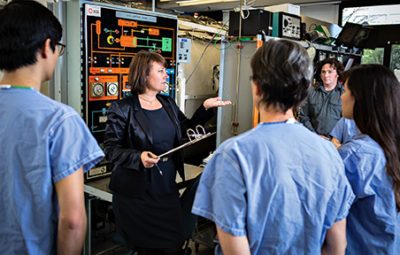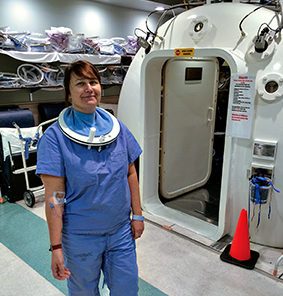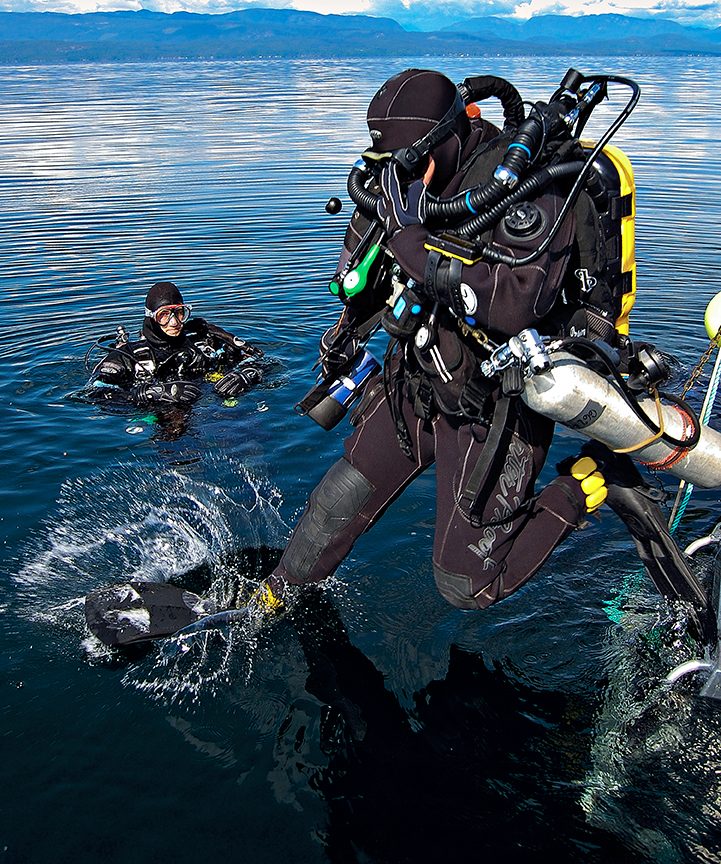An unconventional way into science
SHERRI FERGUSON, MSC, IS THE LAB MANAGER at Simon Fraser University’s hyperbaric chamber, located at an altitude of 1,200 feet on Burnaby Mountain in the outskirts of Vancouver, Canada. She is a scientist working in aerospace and dive research, an experienced recreational, technical, and commercial diver, and a mother.
How did you get into diving?
I was lucky to live in a small community here in Deep Cove, North Vancouver, with a dive shop, and I was living on the waterfront at the time. The story begins with my first dive when I got hit hard with the dive bug, as many people do. It was convenient to dive in my backyard, so I had well more than 100 dives in my first year of getting certified, and I realized that all my money was going to my dive habit. That is when I decided that I’d be much happier if I made my habit into my career so it would pay, which led to me taking all the training I could find to advance my dive skills up to instructor ratings.
I thought the best way to make money was to separate myself from the masses, so the more courses I could teach, the more diving I could do, and I enjoyed learning. I grew a small business producing, building, and repairing drysuits, which took me on the road to visit dive stores and schools to get them to buy our brands or send their repairs to me. Making those connections was invaluable for my commercial and recreational dive network, and I quickly got picked up by dive gear manufacturers and did everything from selling technical dive gear to teaching regulator service seminars up through the 1990s and the launch of recreational rebreathers.
You are a commercial diver as well. How did you get there?
I became a commercial diver in the late ’90s and started on scuba doing easy underwater work such as changing zinc anodes and inspecting dock chains. I worked a bit in the film industry doing water safety for different TV shows filming here, such as The X-Files, and I finally ended up teaching at a commercial dive school and taking on commercial dive work. That dive school was where I had my first encounters with hyperbaric chambers.
Having so many things going on but making my own schedule allowed me to be a single mom and make a relatively good living as a dive industry professional. I later worked for Diver magazine, another great way to make more contacts and extend my network in the dive industry.



You have taken a somewhat unconventional way into dive science. How did you get into academia
While working at Diver, the University of British Columbia (UBC) advertised for a diving safety officer (DSO), and when I looked at what they required for experience, I decided to give it a try. I applied and got my first university job. I was the science program’s DSO, and having that job led to me hearing about a job at Simon Fraser University (SFU) as the chamber operator and hyperbaric facility coordinator. For a while I was doing both jobs part-time, sharing my time between the universities. The first big project I was involved in at SFU was for Boeing. They were interested in blood oxygen saturation levels during sleep as they were building the Dreamliner and the 777. These aircraft were going to fly for 21 hours, meaning they had to have two crews so one could sleep while the other flew. Sleep at the cabin pressure at 8,000 feet was causing some saturation drops similar to sleep apnea, which had potential implications for cardiovascular health and hypertension.
To look at those effects, we had the pilots sleep in the chamber for several nights at different altitudes with all kinds of physiological and psychological monitoring. We discovered that there was a benefit for pilots to be sleeping at pressures equivalent to 6,000 feet instead of 8,000 feet, so to protect the crew’s long-term health while flying long distances, a higher cabin pressure made sense. We also found, however, that altitude did not significantly affect their reaction time, concentration, or performance after sleep.
How did you become the hyperbaric chamber director?
Unfortunately, during one of those experiment days, we had a massive chamber failure that required full service and cleaning of the entire system. Right as we had to shut down the chamber, the engineer on site retired, and I became the engineer, and SFU made me full-time. I fixed the lab and got us through that study, but the university was planning to close the chamber due to a lack of funding. I proposed a new business model for the lab that would make the chamber a shared resource for other departments and outside investors to use for their research.
To live up to my new title, I decided to work on my academic credentials, so I started a master’s degree in biomedical physiology at SFU. The U.S. Office of Naval Research Global (ONR-G) funded my thesis projects, but I had to find other ways to attract research to the lab. What I had seen from running the chamber interested me in the Undersea and Hyperbaric Medical Society (UHMS), and I started attending their annual scientific meeting. The work presented there excited me, and I thought, “This is what I want to do.” In some ways, my passion for dive research had surpassed my passion for diving. I still dive as much as possible, but I have become more selective about destinations.
What was the focus of your master’s degree?
I knew several very experienced divers who died after developing symptoms during their ascent or after surfacing that might have been caused by immersion pulmonary edema (IPE), according to descriptions of their deaths. I questioned if a drop in oxygen partial pressure (PO2) could have caused these deaths. My particular interest in the ascent phase and the connected change in PO2 made me wonder if we would see a difference if we clamped the PO2 when divers were surfacing.
I completed 12-lead ECGs in exercising, submerged, cold-water divers and 12-lead ECGs and blood pressures in simulated hyperbaric chamber dives to 2.4 ATA for 90 minutes with air brakes. After watching how the cardiovascular system, cardiac rhythm, and heart rate variability responded to drops in PO2, I was left with more questions than answers.
What projects are you currently working on?
We have several different projects going on in our chamber. One is a collaboration between myself, SFU’s Damon Poburko, Christian Kastrup from UBC, and his postdoc, Adele Khavari. Initiated through discoveries from a Department of Defense-funded project focused on clotting research, we are looking at factor XII, a coagulation protein involved in the cascade for clotting whose deficiency does not promote bleeding. It is activated with an injury to blood vessel walls (endothelium). Deep-diving mammals and birds that fly at extreme altitudes lack this protein.
We aim to understand if factor XII plays a role in decompression stress and decompression sickness. We have finished laboratory experiments with blood and plasma with and without factor XII in a hyperbaric environment. The next phase is a mouse model that does not express factor XII (called a factor XII knockout), which we will compare to a wild type mouse. We are analyzing their blood, endothelial, metabolic, and mitochondrial function and looking at bubble formation with ultrasounds after decompression.
This is the only way to justify animal experiments — looking at it from all angles before transitioning to human subjects. The goal is to see if we can control decompression stress by suppressing factor XII through pharmacology.
You have also been working with seafood harvesters as well. What is that project about?
WorkSafe BC, which is basically our Workers Compensation Board, is funding that study. We are looking at scientific divers who collect samples or do surveys and seafood harvesters who collect sea urchins, geoducks, and sea cucumbers. We provided about 60 divers with dive trackers, which are small black boxes attached to the diver’s gear that record dive profiles. Through these anonymized trackers, which are blinded as well, we try to see if they dive according to our occupational tables or not. We track their behaviors to understand their dive profiles, see if we can implement computers for this type of diving, and if that would make harvesting and scientific diving safer.
A big part of your work is hypoxia and hypoxia training. What are you trying to find out?
We have pilots coming to the facility to participate in hypoxia training. The only portion legally required in Canada for commercial and civilian pilots is academic. Anyone can teach that, but a lot of pilots want to experience hypoxia and see how they perform under hypoxia.
We involve some of those pilots when they take the hypoxia training to find out if there is a predictor for the drop in oxygen saturation. How quickly the drop happens and how severe the symptoms are is very individual. We are collecting demographics, how frequently they fly, and what type of aircraft they fly (pressurized or nonpressurized).
The study is ongoing with 45 current participants, which is still limited, but so far, it seems that age is the only correlation with the more severe drops in oxygen saturation. Since the pandemic, however, we have had more participants faint than before. This observation is very interesting, but we do not yet have the data to show any correlation. That is likely one of the next studies.
What do you do when you are not in the lab?
I live in a small village in North Vancouver within walking distance of the ocean. My dog and I take a daily walk to the beach. I have recently picked up sea kayaking and obtained my sea kayak level 1 skills certification. I volunteer on several safety and dive boards, including being the chair of the Canadian standard Z275.1 on hyperbaric and compressed-air environments, the UHMS safety committee, the Canadian Undersea and Hyperbaric Medical Association, and the Canadian Association of Underwater Science. I love to travel to places I have never been before, and if I can dive there, even better. AD
Alert Diver — Q3 2022